Mail Age (2 part)
The Italian historian Franco Cardini thought about this in his book “The Origins of Medieval Knighthood”, published in Russia as early as 1987. And there he put forward the following hypothesis of its occurrence. That, they say, at first, the rings were sewn on the clothes of the shamans (and they also participated in the battles and campaigns of the wild tribes in the same way as all other combat-capable men) with a magical goal, and their interweaving between them increased their magic power because “one the ring transfers its power to everyone else. ” And the more rings, the higher was the magical power of such clothing. Therefore, the rings began to be reduced in diameter, and it was here that it turned out that the arrows with bone or flint tips do not pass through such "magic" clothes! Well, as soon as they noticed it, they stopped sewing the rings, and connected them to each other and got a “magic” metallic fabric ...
That is, to search for the place where the first chain mail appeared, follows where the most ancient chain mail could be worn by the priests-shamans who participated in the battles along with the warriors. At first it was just clothes with amulet rings, then a means of protection from arrows, but the “magical” nature of wearing it remained and subsequently, although its origin was forgotten.
British historians believe that by 1066, the chainmail dominated the battlefields, and it lasted long enough - almost two hundred years. In any case, Claude Blair, has repeatedly stated that the “epoch of chain mail” in Europe is the period from 1066 to 1250. Someone has his own figures, but this time frame is most justified, as confirmed by many sources.
The epochs of this epoch are now arranged in the following way: they used welded rings (each ring was made of a piece of wire with ends joined by means of forge welding) and converged, whose ends overlapped each other and were joined by a rivet or a U-shaped bracket. Any chain mail with butt-butted rings, in his opinion, is either a remake or work by oriental craftsmen, although there have always been exceptions. For example, it is a find of chain mail in a burial at Sutton Hoo, although it belongs to an earlier era.
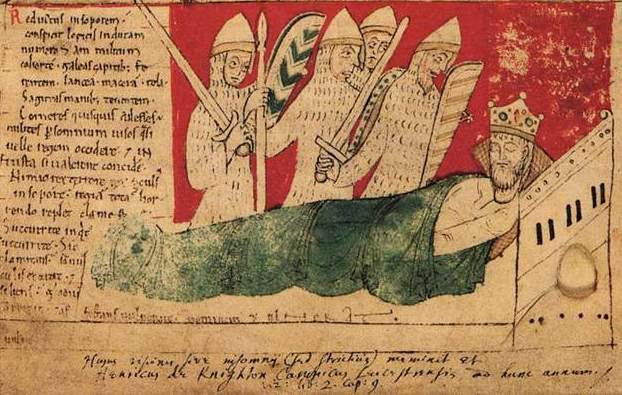
"The Dream of Henry I of England" (the essence of a nightmare: Companions intend to kill the king in a dream!). Figure in the Manuscript "The Chronicles" by John Worchester, which dates from the end of the twelfth century. The soldiers were not belted chain mail (most likely they were worn like that then), and in their hands there were shields in the shape of an “inverted drop”, decorated with images that soon appeared on heraldic shields (British Library)
F. Cardini emphasized the initially magical nature of the armor of interlaced rings, however, undoubtedly, this is the case when the irrational intertwined with the rational with profit. Of course, it does not protect against ramming with a spear, a strong blow with a sword can break it, the same mace can crush a warrior's bone, even through mail, finally, it can be pierced by an arrow with a thin styloid tip. But ... for all that, it was better to have her in battle than not to have, since she undoubtedly increased her chances of survival, because she protected herself from sliding strikes with a sword, from a dagger and light arrows. The number of rings in it reached 20 thousands. The weight was 9 — 13 kg, although the heaviest chain mail from England, preserved to the present, weighs 24 kg!
For the manufacture of chain mail required wire, that is, in the aforementioned period stories its production was put "on stream" and became truly massive. It was obtained from a hot iron rod, which was dragged through a cone-shaped hole in an iron plate. The diameter of the hole with each such broach all the time decreased and, accordingly, the diameter of the wire decreased.
Then it was wound on a rod ("motator") a turn to a turn, as a spring, and on it was also cut. Thus, the rings were the same size. Then it was inserted into a steel bar with a cone-shaped hole, and it was pressed from above with a special stamp. From this ring diminished in diameter, and their ends went one over the other. To connect them tightly, the rings were laid in a “flattener” - where their ends were flattened out with hammer blows. Now they were making holes with a powerful lever “piercer”, because it would be technically very difficult to drill them. Then every second ring could be heated on fire, with rivets being inserted into the holes, and chaining it all together. The remaining rings were riveted already during the assembly process “into the cold”. However, the earliest chain armor had all the rings joined on rivets directly during assembly.
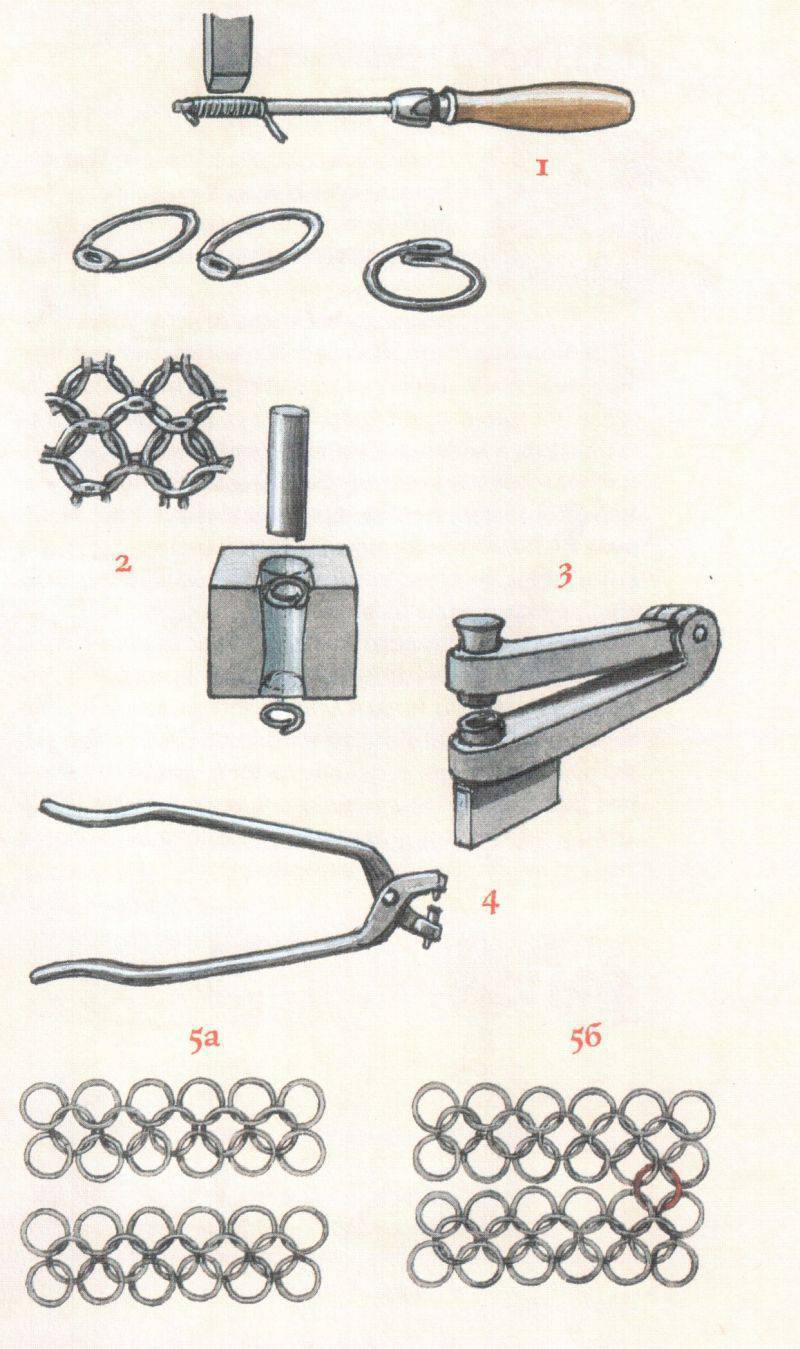
Tools for the manufacture of chain mail according to British historians: 1 - “Motator”, samples of rings and weaving, 2 - “splicing”, 3 - “flattener”, 4 - “puncturer”, 5b - ready-made strips, 5б - connection of two strips
The connection of one ring with four neighbors was considered the simplest, and was the most common. Double chainmail is a combination of one or two rings with eight rings at once, that is, their number almost doubled. But she was hard, though very reliable. In the East, there were other ways of weaving, for example, "1 + 6". And in Japan, the rings were not riveted, but were connected according to the principle of our rings on key rings for keys, that is, they were wound up one after the other, and therefore they had not one coil, but two, two and a half! In terms of weight and consumption of metal, such a chain mail was only slightly heavier than riveted, but the manufacturability of the assembly increased significantly. And it was much easier to fix such a mail.
A sample of the chain mail 1237 of the year, found on the territory of the Zolotaryov settlement on the territory of Russia in the Penza region, where, most likely, in the autumn of the same year, a fierce battle of local residents with the troops of Batu Khan, marching to Russia, reached us. So, we managed to find out that each ring of this chain mail was, firstly, a little flattened, and, secondly, on its flat side there was a semicircular “stiffener”. This mail was restored by one of the Penza craftsmen, Andrey Davydov, and is a real masterpiece of the weaponry of that far-off era. After all, the level of technology of that time was significantly lower than the modern one, and the equipment needed to make such chain mail, which today can easily be made on various machines, was then entirely done by hand.
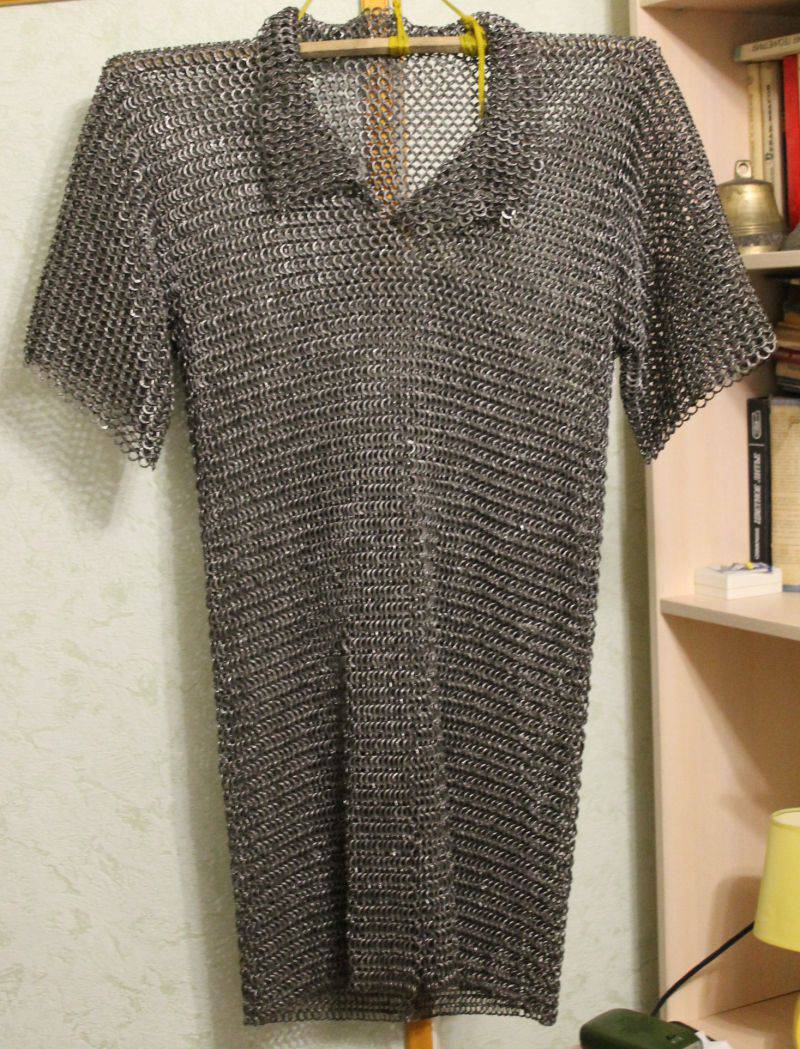
Mail made by A. Davydov from the fragments found at the Zolotarev settlement: external diameter - 12,5 mm, internal - 8,5 mm, thickness of rings - 1,2 mm. All she took 23300 rings. Weight 9,6 kg. All rings are connected by riveting.
From here you can make a number of interesting conclusions. First: the master gunsmith could have either one set of tools for making rings, or two or three sets for making rings of different diameters. But no more, since their value, undoubtedly, should have been very high, since each such set opened the way to prosperity for a person. And from this follows the second conclusion that all the chain mail of that time had about one ring size, or again two or three sizes, but no more. Large rings could not be used, because they gave not too good protection from arrows, while chain mail from too tiny rings also did not particularly protect against anything. That is, this armor in the era of chain mail was sufficiently unified.
Moreover, the number of armor from the rings was simply unique, which, again, was shown by the work of re-instructors. For example, the same Andrei Davydov made baydan (a kind of chain mail with flat rings) “of the Iranian work of the times of Shah Abbas I, on each of the riveted rings of which the names of Allah, the Prophet Mohammed, his wife and children are inscribed. So, according to him, while working on modern equipment, he could not make more 20-30 rings per day and ... how many rings then did the master of that time and for whom did he make such a laborious (and expensive !!!) product.
And here it is important, since we are talking about prices, to notice that already in 1080, X-NUMX su was paid for mail armor in France or gober: twice and even five times more than for a horse. And a warhorse was five times as expensive as a bull, and in the thirteenth century a horse stallion was seven times more expensive than a simple road horse. In 100, becoming a knight in England was very “easy.” It was required to have chain mail, a helmet and a shield, as well as a spear and a sword. A simple soldier was required to have a light-weight chain mail (gobergeon - that is, chain mail with sleeves to the elbow), a simple iron helmet and a spear. The arming of the city militia, who had a quilted caftan, an iron helmet and a spear, was quite simple.
Judging from the illustrations from the 1125-1150 manuscript. on which St. Edmund defeats the Danes, we can conclude that the knightly equipment for the time that has passed since 1066, has changed only in the details! For example, helmets began to be forged from a whole sheet of metal, and their top was bent slightly forward; sleeves are wrist-length; on the head of the knights appeared chain hoods (and the helmet itself, respectively, became more voluminous), and these are all the innovations that the artist was able to notice! Not your mail stockings, not even some horse armor - nothing!
And it turns out that progress in armament seems to have been, but it was going very, very slowly. But here much depended on fashion and on the knight’s wallet. For example, there were historians who studied the drawings of the Winchester Bible (1165-1170) and noticed that although the length of the armor remained the same as in 1066, the knight's figure changed visually very much. Why? Yes, because there was a fashion to let out from under them long caftans to the ankles, and even bright colors!
According to the English historian C. Blair, the most surprising thing, however, is not this, but the fact that he did not find at one time sources in which it would be indicated that the knights wore some kind of quilted dress under the coat of armor, although there is no -no rigidity is obvious to her. And, nevertheless, up to the end of the 13th century, the only quilted element of a knight's clothing was a cap on his head! In the famous manuscript of this period, the Bible of Macieus, there are many images of chain mail that they put on and take off, and in all cases the only clothes under it are a colored shirt with sleeves to the wrist. It remains only to assume that some kind of lining could be on the mail itself, only to prove this assumption today is almost impossible.
Since 1150, knights of kalechnuyu cloth, called hosen in England, have come into common use of knighthood. They were fastened to the belt, and put on under a chainmail shirt. Some were knee-length, while others could reach mid-thigh. Their earlier form is a kolkuzhnaya band, which went along the leg in front and behind, which had ties. Later form - real chain stockings lined with fabric. But protective quilted clothing, worn with chain mail, and without it at this time there were three types at once. These are camisole, gambeson and aketone, although the ways in which they differed are extremely difficult to answer today.
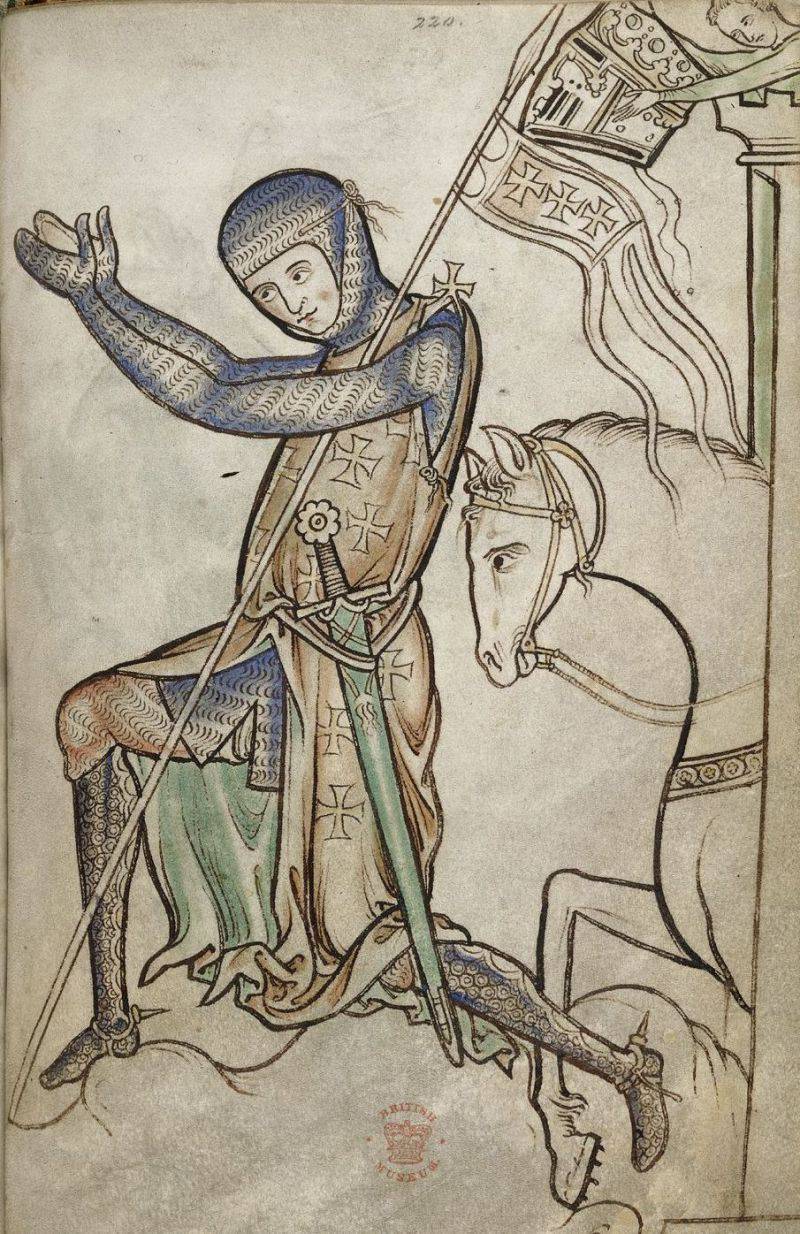
The Praying Crusader is a miniature from the Winchester Psalter. Second quarter of the 13th century It is shown in a typical for its time protective armament: a chain haberge with a hood and original routes on the front part of the leg from metal disks on rivets. It is possible that the cross on the shoulder has a rigid base under it, well, let's say the shoulder strap of a leather cuirass, which is covered by surco (British Library)
Perhaps, these terms were already used arbitrarily and in meaning they were interchangeable. In general, British historians believe that the knight now looked much brighter and more colorful, but the color of the metal in his figure still prevailed. Under his metal clothes, the knight at that time wore a bre - linen trousers up to his knees, and a long shirt, also up to his knees, as much as possible silk or, at least, linen. On the legs wore stockings of fabric, on top of which the chain armor's knives were tensioned on the lining. Over the shirt a kaftan of fine cotton fabric and a hambezon made of leather or coarse linen was worn. The head was necessarily covered with a quilted cap, since the mail hood itself was never worn on its head.
At the end of the twelfth century, most likely as a result of the influence of campaigns to the East, the chain mail was supplemented with a hood, and sleeves with gloves, well, and the stockings-shoss began to be worn everywhere. At first, for obvious reasons, the sleeves of chain mail did not reach the brush. Warriors wore leather mittens or gloves, but when they had long sleeves at their armor, ending with chain mail mittens leather hemmed, they were abandoned. In the middle of the palm, each such mitten had a cut, which allowed at any moment to free their hands, which, of course, was a very convenient invention. Somewhere after 1250, there were also chain mail gloves with separate fingers, however, the knights did not refuse the earlier version, since the version with separate fingers was more expensive. Such an outfit became the standard knightly vestment. This is evidenced by the relief 1210 of the year with the figure of a knight from the church of St.. Justin is in Pydna, where his entire body is covered with chain mail from head to toe, and the helmet has a face mask with holes for breathing and for the eyes, so that the person on it looks like a metal statue.
Then came the so-called surco, or cotta. She looked like long-sleeved clothing with cuts in the front and back and long sleeves, which she, however, gradually lost. The functional significance of such clothing seems to be obvious - protection from the sun's rays. But many historians consider its appearance not so much the result of acquaintance with Eastern culture (where Muslim warriors wore armor covered with cloth) as fashion and want to stand out among other things with the quality of the fabric and their wealth. Surcue is believed to have served as a protection against the weather, and they refer to the popular knightly poem "Confession of King Arthur":
Clothes green
So that the armor is clean
The vagaries of rain are not terrible.
It is doubtful that such clothes could effectively protect against rain, because this is not a raincoat mac! There is another theory that it was a convenient way to show the heraldic signs of the owner of this surco. Unfortunately, this is not so easy to prove, since, although the developed heraldic system and the fashion for nalatnaya clothes appeared about the same time, it is well known that images of heraldic signs were not always met on them. In the same way, a soroko or cotta was not always sewn from fabrics of heraldic flowers from the coat of arms of a knight.
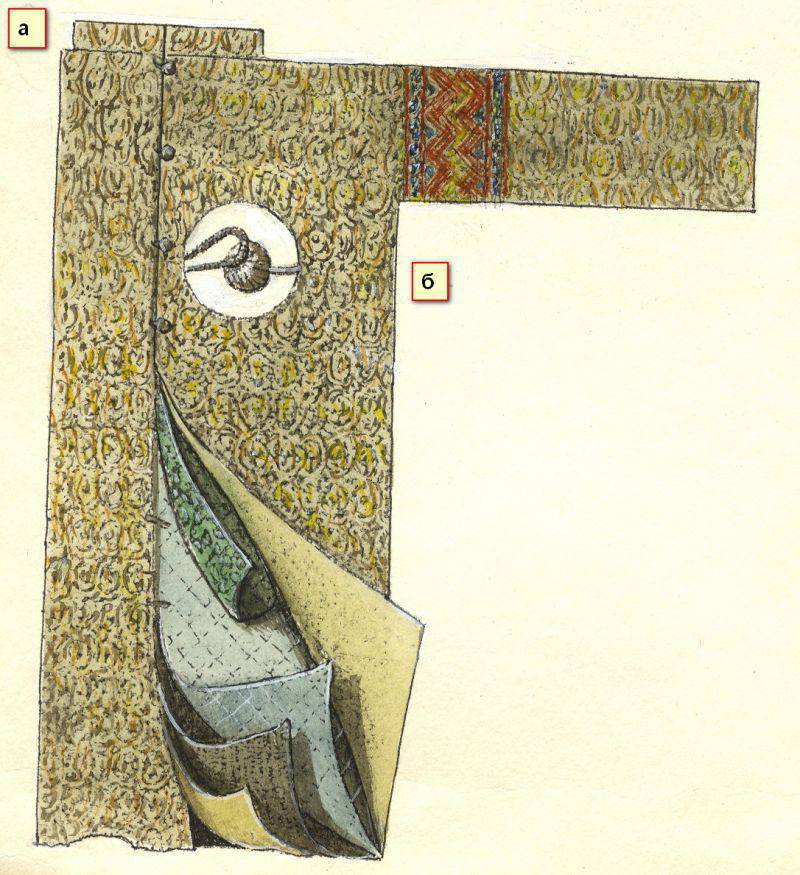
The east armor of Gazakhand (a), described by Osama ibn Munkyz and belonging to him: the first layer is a linen lining, oriental chainmail is woven from small rings, cotton quilted lining, “Frankish mail” from large rings and a patterned fabric on top. Button-fastener armor (b). Fig. A. Shepsa
It can be assumed that the fashion for them arose under the influence of the church, since the warrior in the mail looked very "anatomical", which made it inappropriate to walk in it over time. But a white surco from an ordinary canvas with the same crosses sewn onto it, gave the knight and protection from the sun, and immediately showed everyone who was in front of him. At first it was so long that it almost reached the toe. But this prevented the knights from going up the stairs and getting into the saddle. Therefore, its length was soon reduced, so that the classic surcoat was only a little to go behind the knees of a warrior.
In the XIII century, surcoe became especially popular, but there was still no common point of view with what exactly fashion was associated with walking in armor, covering them with clothes, among English-speaking historians. True, in English, the words “coat of arms” and “chain mail” begin with the same word “koat”. In the first case, “Coat of Arms” is “clothing for weapons", In the second - it is" koat of mail "-" clothes of chain mail. " That is, the heraldic meaning of this term seems to be obvious and does not cause doubts, although medieval images show us that images of the coat of arms of a knight on a suko are not always applied, which can be clearly seen in the miniatures of the famous Manesky Code or the Great Heidelberg Manuscript.
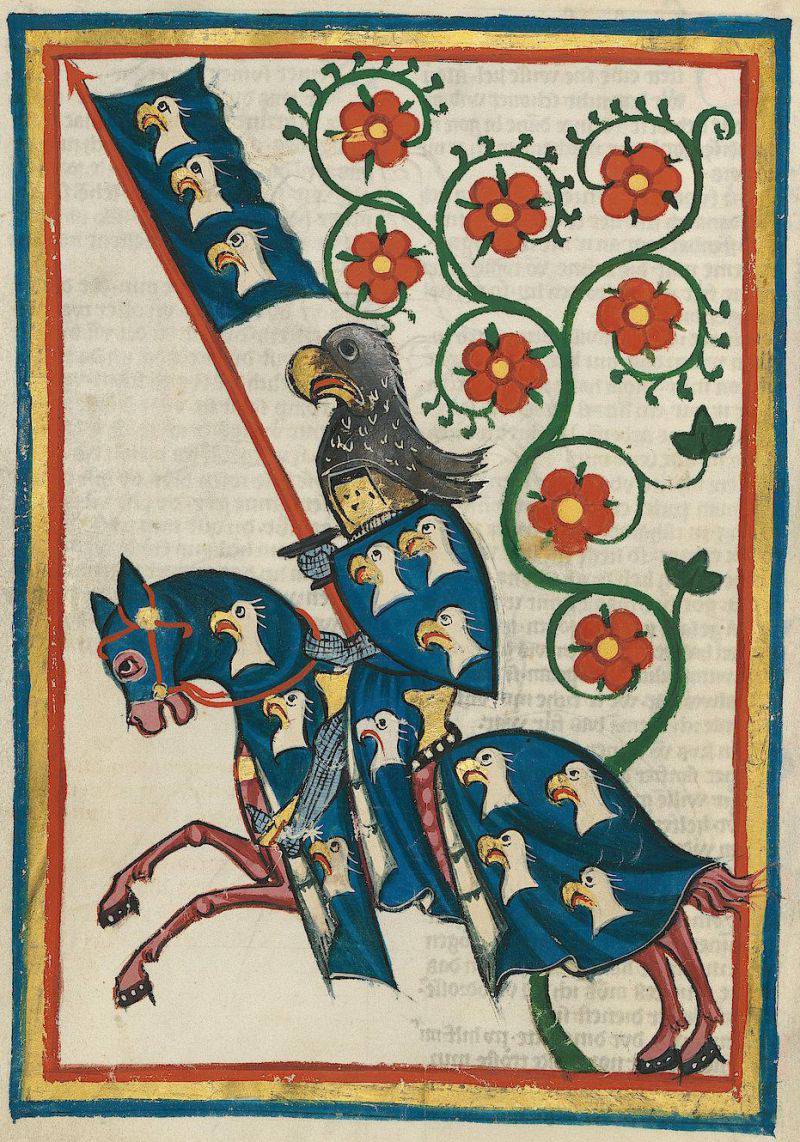
Hartmann von Aue. A miniature from the “Codex Codex”, 1305 - 1340 It is considered a classic depiction of a knight of that time. In fact, however, more often it happened that the horse’s blanket was of one color, surco — another, and the coat of arms on the shield had nothing to do with their colors and drawings! And, by the way, the same “Codex Codex” confirms this (University Heidelberg Library)
The earliest depiction of Surcoil is the figure of Valeran de Bellomonte, Count Mellan and Count Worcester on his seal, dated 1150 year. The dress itself looks very unusual - his sleeves are up to his wrists. Such a cut appeared again only in the second half of the XIII century, and until the second half of the XVI century it was not often met. Up to the hips, it fits snugly to the body, then diverges in the form of a wide skirt to the ankles, and has a slit for riding comfort. They are in the Winchester Bible, and on the Great Seal of King John (brother Richard the Lionheart), which date back to about 1199 a year.
Before 1210, surcoe's images were rarely met, but then he was apparently recognized, and it became massive. Until 1320, he had the appearance of a sleeveless robe with large armholes and a skirt with a slit that reached the middle of the calf, but the length was quite ordinary and to the ankles and to the knees. From 1220, sleeves to elbows appear, although there are very few images of such surcoats.
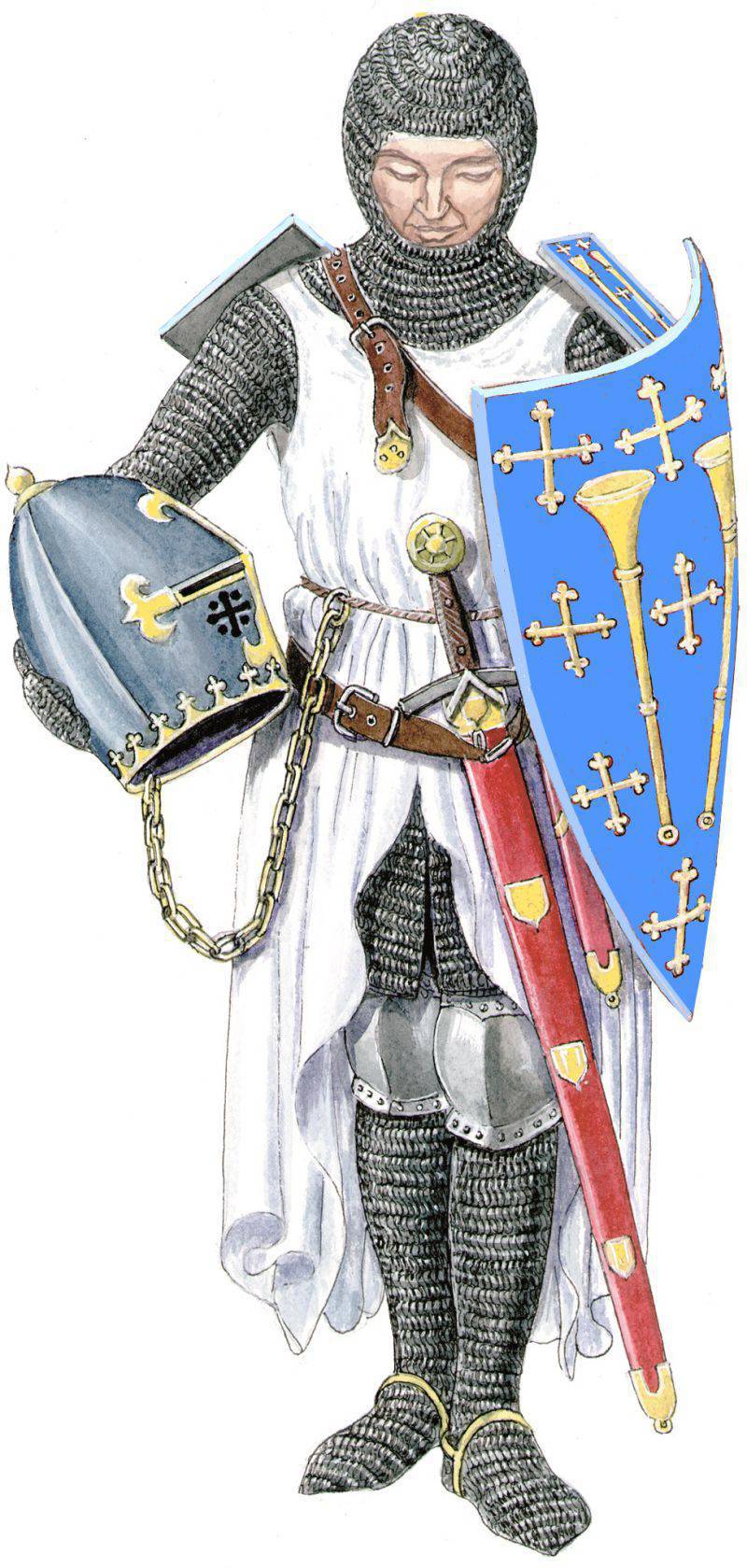
Roger de Trampington. The outward appearance was reconstructed by A. Sheps by effty from the Trampington church in Cambridgeshire (d. Approx. 1326)
The historian E. Oakeshott does not use this term, but calls this dress cotta, indicating that it was not included in general use until the 1210 year, although some examples of this attire appeared on knights before the end of the 12th century. He also believes that the exact purpose of her is unknown, they say, it was a funny “trifle”, a cheerful and colorful outfit that turned the outwardly figure of a sullen and stern knight in a dark brown-gray coat in a gallant and brilliant gentleman - quite in the spirit of the times and that the heyday that knighthood reached at the end of the twelfth century.
Well, the conclusion from all of the above will be the following: chain mail as a type of protective armor appeared a long time ago and initially, unlike functional scaled armor, wore a “magic” character. Then its functionality was also proved by practice, and the “age of chain mail” began. Moreover, the “century” is characteristic ONLY FOR EUROPE, because for a long time no mail was used in Asia in Japan, it was not popular in China, and in other countries it began to be supplemented very early with records. In Europe, the “age of chain mail” had a clear time frame and localization. But the "era of chain mail" is by no means over. It is the fifth phase. But what happened next with the armor will be explained in the following materials.
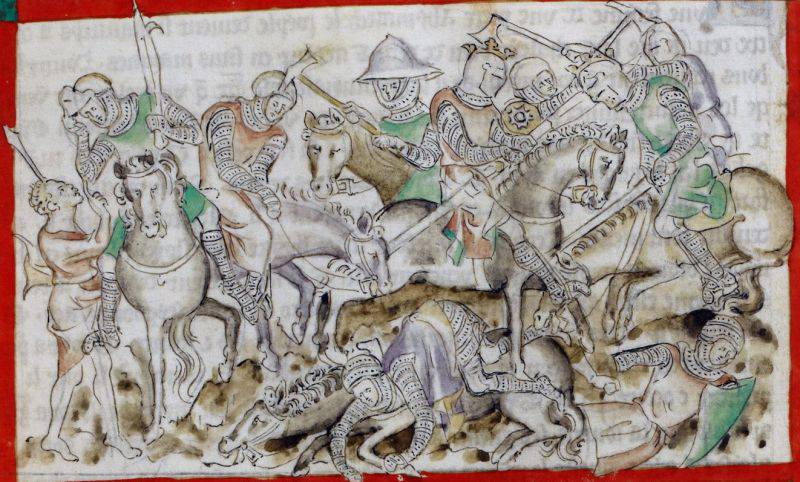
Information